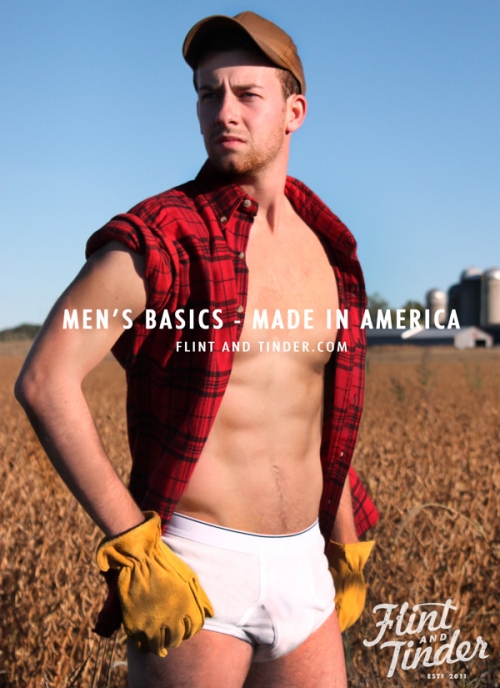I just bought some underwear, and let’s just say I’m excited about them. Here’s why.
99% of underwear sold in this country—indeed most of the clothing we buy—is made in places like China, Indonesia, or Thailand. That’s why they’re so cheap.
And that’s also why they don’t last long. And why they don’t feel very comfortable.
You can probably guess how I feel about sweatshops and outsourcing, but we also know that American companies do this to stay competitive, and my God, we do love our cheap clothes, don’t we? Plus, I’m in no position to preach. I’ve bought my fair share of Eddie Bauer shirts (made in India) and Nordstrom pants (made in Malaysia) without a thought about where they were made. It’s just that lately I’ve been on a minor made-in-America kick, so when I saw a Kickstarter post for a start-up called Flint and Tinder (which, as far as I can tell, is really a guy named Jake Bronstein) selling homegrown men’s underwear, I got out my credit card.
I’d contributed to Kickstarter only once before, when a friend of mine wanted to go to Africa for a research project. Here’s how it works: You have a great idea, organize it, post it, and hope that people pledge enough to support it (mostly in small denominations) so you can reach your target dollar amount. If so, you get a kickstart: their credit cards get charged, and you get the money. Dreams come true.
Or not. My friend’s project didn’t make it. And typically you see weird, off-beat stuff like flavored whipped cream, newly designed guitar picks, animal ears you control with your mind. But these guys from Flint and Tinder seemed to have their act together. (That is to say, Jake seemed to have his act together.) They were going to sell men’s underwear, made in America from crotch to waistband, and for every thousand pairs they sold, another American job would be created. No lie. And they weren’t just starting up one large factory in one place; instead, this project would open up jobs all across the country. So I wouldn’t just be buying something made in America; I would be helping to create American jobs.
Done deal. I ordered a three-pack of boxer-briefs.
Then forgot all about it.
Weeks passed. In May I heard from Kickstarter that Flint and Tinder had garnered 5577 backers and reached their target. My credit card would be charged.
More weeks passed. I got another email. Flint and Tinder had received a whopping 971% of their funding, almost $300,000—the biggest success story in Kickstarter’s short history. I ordered the type and color of my underwear. It would be delivered in June.
A month passed. Jake Himself wrote to apologize—they were overwhelmed with orders, and shipments would be delayed. Until maybe late July, even. I wrote back: “Jake, I don’t care. I believe in what you’re doing. Take your time.”
Then, I forgot about them again. I mean, it’s just underwear, right? It’s my position that as a man, if you think about your underwear too much, then you’ve got what my father used to call “mental problems.”
Finally, in mid-October, I received the package.
The first surprise was the color. I had ordered navy blue, but what I got was more like sky blue. Garanimals blue. Underoos blue. With a bright white stitch at the crotch. Okay, so this would be a tough one to wear around the locker room at the gym. Good thing I’m not going to the gym too often these days.
The second surprise was the comfort. When I put them on, I realized, for the first time in my life, what underwear were supposed to feel like. I can’t really get too specific here, but let’s just say that I had gotten used to feeling either “bunched up” or “loosey goosey” “down there.” (Really, the older I get, the more I speak like my father.) So when I put on my Flint and Tinders and felt the effect of thick, 100% American cotton cut for an American man’s body (not cut to maximize the fabric for minimal comfort, the way underwear made in China, India, and Thailand might be), I felt like a guest on Oprah: fully supported.
The third surprise: the map showing where everything was made. I knew they were spreading out their economic footprint, but I had no idea how big and fun it all was. Cotton picked in California was made into yarn spun in Georgia, which was knitted, dyed, cut, sewn, and packed in Pennsylvania, and then shipped—to men like me. Plus elastic from Massachusetts, tags/labels/thread from Georgia, printing in New York, boxes and envelopes from Texas . . .
I mean, how cool was this?
But best of all, they felt great.
So now I’m on a major made-in-America kick. My wife and I just moved from a tiny apartment to a house, so we’ve had to get some furniture. We’ve been making use of craigslist and hand-me-downs, but we’ve also bought some pieces made in America—a bedroom set from Pennsylvania, a couch and loveseat from North Carolina, a picnic table handmade by a guy in Castle Rock, a massive table made by the owner of a furniture store called Lee Alex in Denver, and so on. They cost more, so we’ve bought them one at a time, saving up for each, but they are really, really well made. If we went to the big furniture warehouse down the road and bought everything at once, we would have saved well over a thousand dollars, but I doubt it would last as long as this furniture will—and I doubt I’d feel as good about buying it.
So this has started something. Now, when I think about buying a beer, a power tool, or a new sports jacket, I check out where it’s from, where it’s made. And it’s amazing how often it’s from India, Thailand, or China (or Mexico, if it’s food). If you know me well, you know that I’m a pretty cheap guy. But I’m starting to realize that the eggs from the nice couple two doors down ($3) tastes way better (the yolks are orange, for God’s sake) than the $1.99 (pale yellow-yolked) eggs at the supermarket, and the made-in-America shoes that costs $95 a pair are way better, and will last longer, then the $29-per-pair shoes made in China.
And here’s the good news: there’s a long list of companies manufacturing in America, hiring American workers, selling all kinds of stuff. (Many of them are listed on this site: www.stillmadeinamerica.com)
So I’m all in. Locally grown food, small companies, kickstarter start-ups. American made and trustworthy. This is what patriotism feels like to me—not bombing other countries. Supporting someone I trust instead of a mammoth corporation. Helping out the little guy. For ten years of his life, my dad owned a deli in Ardsley, and business limped along until he finally had to bail, because everything people got at his store they could get cheaper at Walmart or Super Target or the supermarket 10 minutes away. This is probably the source of my new shopping strategy; it comes from wondering why more people wouldn’t want a great sandwich from Sam’s Convenience Mart rather than the crap they served at Subway. Probably because of that, I get inordinately happy buying stuff from local shops, even if it costs more. In fact, right this minute, I am waiting for a call from my man Olin over at Quality Auto Care, seven blocks away from our house. They’re swapping out the spring tires on my wife’s car for her winter tires. Costco would have done it for a little less, and so would Pep Shop Boys, but I like Olin, I like the guys that work there. And if anything happens to those tires, they’ll replace them, and they’ll rotate them for free, and they’ll even balance the air pressure whenever my wife feels a little pull during her long commute. That’s the kind of thing I’m talking about.
I’m well aware that not everyone can do this. I’m well aware that for most people, getting something at Walmart or Target is all they can afford. So I’m not saying that other people should do what I’m doing. But the way I figure it, I’m lucky to have a job, a good income, and a wife who also has a job, so maybe one thing we can do is give the local guys our business, and pitch in the occasional $36 to fund great new start-ups like Flint and Tinder–and in so doing, contribute to a change in the way Americans shop.
It might cost a little more sometimes, but aren’t we worth it? Isn’t America worth it?
![]()






Leave A Comment